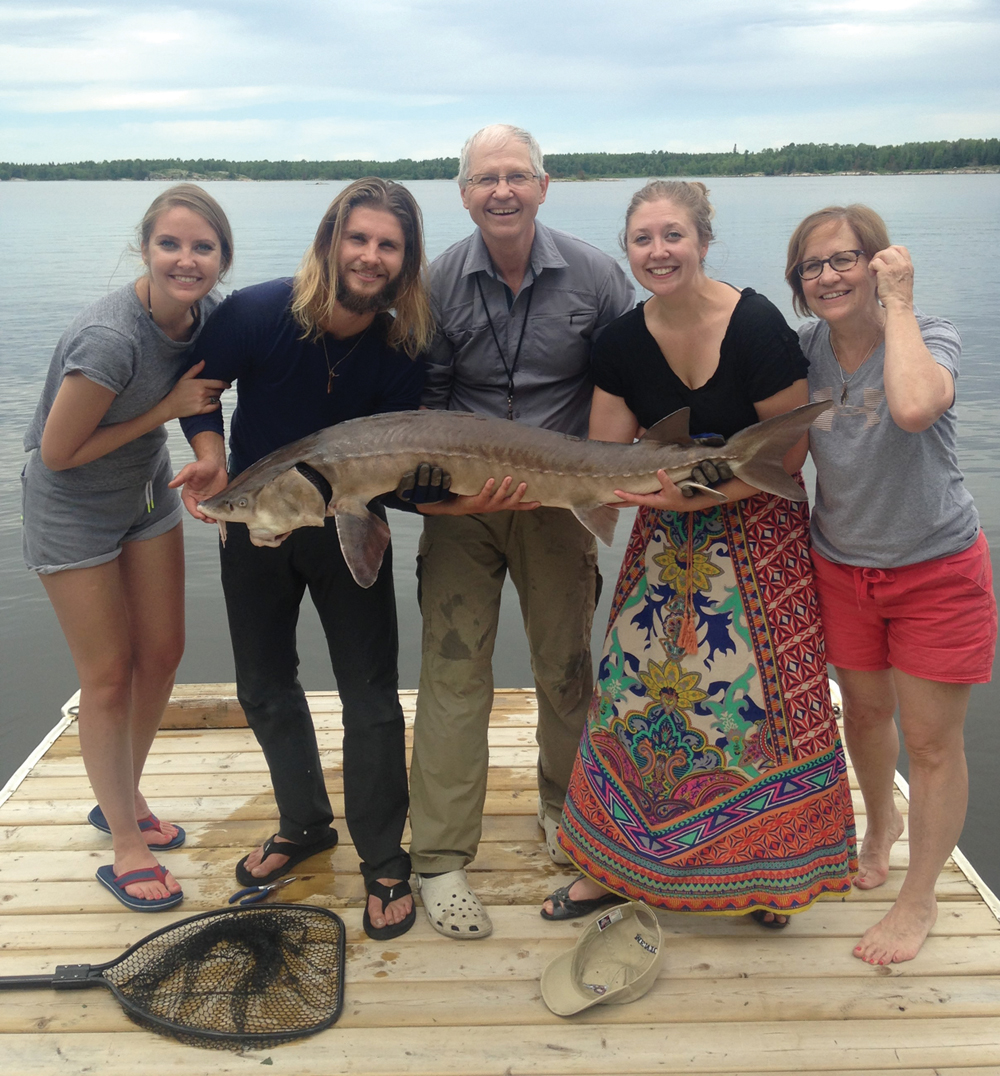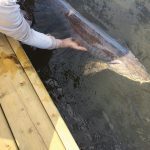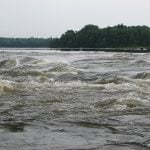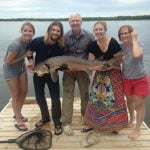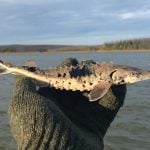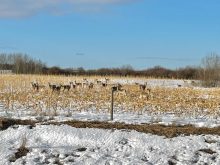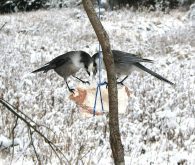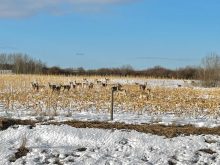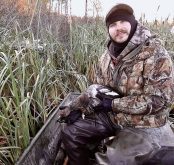sturgeon_falls_2_TIM_SOPUCK_cmyk.jpg
The head of the rapids at the aptly named Sturgeon Falls on the Winnipeg River provides an example of spawning grounds.
Photo: Tim Sopuck
Family_and_Sturgeon_TIM_SOPUCK_cmyk.jpg
The Sopuck family with a 125-centimetre sturgeon caught off the family dock on the Winnipeg River.
Photo: Tim Sopuck
sturgeon_TIM_SOPUCK_cmyk.jpg
Tim Sopuck with a 130-centimetre sturgeon.
Photo: Tim Sopuck
Sturgeon_with_mouth_extended_TIM_SOPUCK_cmyk.jpg
The mouth of a sturgeon, normally retracted into the mouth, can extend down like a piece of vacuum cleaner hose.
Photo: Tim Sopuck
Yearling_Sturgeon_GOVERNMENT_OF_MANITOBA_cmyk.jpg
Juvenile sturgeon are well protected by sharp, bony plates on the back and sides.
Photo: Government of Manitoba
If I were asked to name the most interesting fish in Manitoba, it would be the lake sturgeon.
They have an ancient lineage that goes back to the time of the dinosaurs. In fact, a modern sturgeon looks pretty much like the fish that were swimming around all those eons ago. They are the biggest, oldest fish in any of the waters they inhabit.
Until a few centuries ago, they were also a dominant species in our region’s larger rivers and lakes.
Read Also

Manitoba Ag Days 2026: Local businesses gear up for Brandon farm show
Most of agriculture is seemingly at Manitoba Ag Days each January: Manitoba agribusinesses and farm groups look forward to connecting with farmers at the 2026 show.
Those populations were decimated after European settlement. It’s only been relatively recently that the sturgeon’s story has regained some notes of optimism, thanks to better knowledge and management.
Why it matters: Recent improvements in sturgeon numbers highlight the importance of strong science, sound management practices and the need to stay the course.
As one fish biologist once summarized for me, sturgeon are the unicorn of the fish world.
Its unique features start with the fact that, like sharks, sturgeon skeletons are made of cartilage, not bone. They don’t have scales. Instead, their bodies have rows of sharp, bony plates called scutes. The tail is also very shark-like, being much longeron the top than the bottom. The mouth sits below a narrow, flattened snout and has an extension that looks like a section of vacuum cleaner hose when it hangs down. This setup is meant for bottom feeding, and is aided by four prominent whiskers loaded with sensory receptors.
Sturgeon usually inhabit deep waters, methodically searching sediments for aquatic invertebrates, leaches, small clams and small fish. It looks remarkably out of place with most fish in our waters today, but the sturgeon’s adaptation package has been successful for 200 million years.
Another standout feature is how long sturgeon live. About a decade ago, my family caught a 125-centimetre tagged sturgeon from the dock at our cottage on the Winnipeg River. When I reported the tag number, I was told it was 51 years old.
By sturgeon terms, that was not a very big fish. The species often lives at least 80 years. In comparison, an old walleye might reach 25 years. That span is typical for most other fish in our waters.
The historical lifespan for sturgeon is unclear, but one large specimen caught in Lake of the Woods decades ago was estimated to be more than 150 years old. The largest recorded sturgeon taken in Manitoba was caught in the Roseau River in1903. That one was over three metres long and weighed 185 kilograms, according to the scales of the Dominion City grain elevator at the time.
While sturgeon may live a long time, they also take forever to reach sexual maturity. Females don’t start laying eggs until around age 20 and they may only spawn every three to seven years. Recent studies suggest that sturgeon may have many years of spawning failure between seasons of success.
Use and overuse
Indigenous people had seasonal routines that often included visits to known sturgeon spawning areas, usually below large rapids. In addition to eating them fresh, dried sturgeon pemmican would also be prepared for future meals and the tough skin could be used to make bags. Sturgeon products were also used as trade items.
European explorers and early settlers found waterways teeming with big sturgeon. They were often viewed as a problem, at least at first, as they played havoc with delicate gill nets. There are stories from early European settlement times of the oily sturgeon being dried whole, stacked like cordwood and used as fuel for steamboats. There seemed to be so many that people didn’t give a second thought to such low-end uses for the ancient fish.
Later, a commercial trade developed for caviar, smoked sturgeon meat and even for sturgeon swim bladders, which were dried, powdered and used as a clearing agent for wine and beer. Some areas gave up truly remarkable catches for a short while, but these fisheries always collapsed.
There isn’t a single case of a commercial sturgeon fishery being sustained in the long term in Manitoba waters.
The sturgeon’s sensitivity to over-exploitation stems from its longevity and late maturation. The massive populations that early commercial harvesters encountered were mostly large, older fish that, when removed, quickly left a population without mature fish.
Changes to the water landscape have also contributed to falling populations. Damming and diverting major rivers, as Manitoba has commonly done for hydroelectricity, submerge fast water areas that otherwise would have provided spawning habitat. They also interfere with fishes’ ability to navigate a waterway.
The road to recovery
The great news is that sturgeon numbers are slowly recovering in some waterways. One success story has been the Winnipeg River, which is an important engine of the Manitoba economy. We have harnessed most of its hydroelectric potential, all of which keeps our lights on, our houses heated and our industry humming.
Commercial fisheries were also taking out large numbers of sturgeon while some of those dams were being built, although those enterprises sputtered out in the late 1950s.
In an effort to kickstart a recovery, the province instituted a conservation closure in 1993. This banned the taking of sturgeon by recreational anglers and local Indigenous communities. In the 1960s, when my youngest memories kick in, recreational fishing regulations allowed people to keep one fish a day. If one was caught, it was kept.
Manitoba Hydro also started funding intensive research studies that carry on today. Winnipeg River sturgeons are now one of the most studied populations of the species on the planet. This body of information has helped adjust views of sturgeon management.
Populations are increasing in many reservoirs of the river. In Numao and Nutimik Lakes, just downstream of Slave Falls, survey efforts noted twice the sturgeon catch rates in 2020 compared to 2006. Considering how slowly these fish grow, that is a tremendous improvement.
Ongoing research has also added a remarkable level of detail to our understanding of fish movements. We now have evidence that sturgeon are more of a stay-at-home fish than previously thought. There are some stretches between dams on the Winnipeg River where the original rapids remain, and it turns out that sturgeon movement between these fast-water areas is minimal. There are also signs of successful spawning below dams and other areas of fast water.
In a nutshell, the research points to the ability of the Winnipeg River to sustain decent sturgeon populations even with the dams in place, assuming we have truly learned not to over exploit them.
A new fishery for the Assiniboine River
Once-robust sturgeon populations were eliminated from the Assiniboine River decades ago, but there has been a long-standing hope that reintroduction is possible.
As Manitoba fisheries managers explored different management approaches, they learned to rear sturgeon in local hatcheries. Young sturgeon are finicky feeders, which makes hatchery culture a tricky business, but early successes led to a source of fish. Modest numbers of young sturgeon, as well as 91 adults from other waters, were stocked in the Assiniboine River from 1996 to 2015.
Today, Westman anglers regularly report sturgeon catches, including some large fish that make the annual Master Angler list. Recent surveys have also found juvenile sturgeon that most likely came from natural reproduction. With strong evidence that sturgeon are becoming a self-sustaining population there, fisheries managers can begin to think about kickstarting sturgeon recovery elsewhere.
Fun with sturgeon
My family’s multigenerational tales have two mentions of sturgeon caught from shore at the Winnipeg River cabin in the ‘50s,but there was a long drought after that. I finally caught one about 25 years ago and, since then, we have brought about a dozen to the net off our dock.
In keeping with the regulations, we don’t target sturgeon. We use pickerel rigs baited with worms or minnows to aim for walleye, perch and pike, but every now and then, the rod bends in a way that tells us it’s a new game.
I won’t get into the tug-by-tug details, but sturgeon are one of the hardest-fighting fish I’ve ever caught. The sight of this ancient marvel coming into view from the deep always takes my breath away. Fortunately, sturgeon are remarkably resilient and have very high survival rates after being released by anglers.
While catching one is always special, our most enduring enjoyment of sturgeon comes simply from watching them. I know that sounds strange; sturgeon hug the bottom under 15-25 metres of water. Occasionally though, they will rocket to the surface and leap wildly into the air.
Theories abound about the reasons. Maybe it’s an attempt to dislodge parasites, a way to expel air or even a means to communicate with other sturgeon. These are only guesses really, so if someone tells you they know why sturgeon jump, don’t buy it.
When I was a kid, a sturgeon breach was seen a scant few times per summer. Now, with much higher populations, they are a daily occurrence and a reminder that sturgeon numbers are going in the right direction.
My wife is not one to pick up a fishing rod, but when she relaxes on the dock, she also keeps a vigil for breaching sturgeon. It’s a big deal for us (and our neighbours too, for that matter), so we recount every sighting.
A special fish
We owe it to future generations to do the best job we can to conserve and, where possible, restore the remarkable diversity of nature to which we have been endowed.
With sturgeon, I see an added onus: these special fish are a 200-million-year-old biological success story, but they have been no match for our short-sighted exploitation. Now that we know better, and have set a responsible course to act better, we must not let up.




